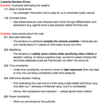Decision Making Flashcards
2 tools for decision making
Decisions can be made through linearity and likelihood.
2 factors/influencers of decision making
- how people think (cognition)
- contextual elements (e.g. teams, time)
General Model of Decision Making
1. Identify the problem
- Define objectives (parameters of success)
- Make a pre-decision (most critical for mitigating decision biases and errors)
- Generate alternatives
- Evaluate alternatives (balanced view)
- Make a choice
- Implement (the chosen option)
- Follow up
Linear Decision Making
Linear decision making is characterised by a person’s reference for using external information and processing it via logical and rational thinking.
Much better than unstructured estimation.
- Brunswick’s Lens Model
- Pro and Con tables with weightings
Core Beliefs of Linearity
- Psychology should give equal attention to the environment as it does to the organism itself.
- Brunswik’s model aims to explain how to make decisions.
- Experience will allow you to scan the decision environment efficiently — ‘intuition’.
Why linear models are consistently outperform predicts made by experts
Linear decision models are better than judges when selecting the right choice because they reduce misrepresentations of X’s and β’s.
- Tend to lack insight into their own decision making
- Tend to rely only on a few cues
- Low inter-rater agreement about the weights
- The more information it is presented, the more confident they become in their decision
- Experts do a good job of correctly selecting the variables that are important in making a decision, but a linear model tends to utilise these variables more efficiently than humans.
Bruniswik’s Lens Model - Description
Linearity
β = weight/importance (0-1)
x = cues/criteria (0-10)
- Cons will be minus
- Pros will be plus
- some criteria will not be known to us - a big limitation
tscore = total score of the option considered
- the highest total score will represent the best decision.
- Linear decision models are better than judges when selecting the right choice because they reduce misrepresentations of X’s and β’s.*

Bruniswik’s Lens Model - Issues

human biases in probability/likelihood assessments
We anchor to the positive/initial given (‘anchor’ = rely on too heavily)
- rely on information that is certain and not difficult to calculate
- moreover, initial figures future estimations
- e.g., knowing prefious salaries
- do we focus on potential profits or initial resources?
We panic when in the negative
- we are risk-seeking when framed negative
Framing Effects
Individuals tend to be:
- Risk averse when they are in a positive frame
- Risk seeking when they are in a negative frame
Implication: People have different preferences and make different choices when a situation is framed in terms of losses or in terms of gains.
Framing Effects in organisations
escalation of commitment
goals (must be SMART, be difficult, give feedback)
- Goals provide framing effects (gain vs. loss):
- Are we above or bellow a goal?
creativity
- Reframing the problem –> other [creative] ways to achieve the same goal
Escalation of Commitment in detail
3 requirements
2 powerful drivers of escalation
reducing commitment
3 requirements:
- A substantial previous investment of time and money.
- Clearly negative information regarding the previous choice.
- Dilemma of either abandoning the previous course of action or continuing commitment.
- When responsible for the initial choice, decision makers tend to throw good money after bad and escalate their commitment to losing courses of action
- people don’t want to admit mistakes;
- underestimate the negative consequences
When is escalation of commitment error most powerful?
- big previous investment
- it’s important to complete the project
How to reduce escalation of commitment?
- Reduce the level of felt responsibility by changing the decision maker
- Reduce the need to “save face”bylowering the threat of punishment
- Task the decision to groups
main difference between the Brunswikand the Bayesian model
- Brunswik model is focused on accuracy based on cues and betas
- Bayesian is based on probability
Example of Framing Effects
People are much more sensitive to loss than gain.
(A vs. B) Here, the risk is presented in terms of gains so people tend to choose option A (72%), which is, in fact, worse.
(C vs. D) Most people (78%) choose B because the problem is presented in terms of losses. People suddenly prefer to take a risk. In fact, if you look at both the situations you’ll see that, mathematically, they’re identical and yet people’s decision is heavily influenced by the way the problem is framed. This effect has been termed preference reversal.



